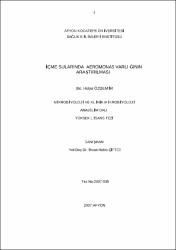| dc.contributor.advisor | Hakkı Çiftci, İhsan | |
| dc.contributor.author | Özdemir, Hülya | |
| dc.date.accessioned | 2015-04-09T08:08:25Z | |
| dc.date.available | 2015-04-09T08:08:25Z | |
| dc.date.issued | 2007 | |
| dc.date.submitted | 2007 | |
| dc.identifier.uri | http://hdl.handle.net/11630/3734 | |
| dc.description.abstract | Bu arastırmada, Afyonkarahisar ilindeki toplam 70 su örneğinden izole edilen
Aeromonas cinsi bakterilerin varlığı, sıklığı ve antibiyotik direnç paternleri incelendi.
Đncelenen 70 su örneğinin 16’sı (%22,9) kaynak suyu, 54’ü (%77,1) sehir sebeke
suyu idi. Etkenlerin izolasyonunda seçici besiyeri olarak Ampisilinli kanlı agar
kullanıldı. Elde edilen izolatların tanımlanması Aerokey-II yöntemi ve Becton
Dickinson(BD)-Phoneix-100 otomatize sistemi ile 2 farklı sekilde yapıldı.
Aeromonas izolatlarının direnç paternleri Clinical and Laboratory Standarts Instutute
(CLSI) 2006‘ya göre değerlendirildi.
Su örneklerinin 6’sında (%8,6) Aeromonas türü saptandı. Aerokey-II
yöntemine göre izolatların dağılımı; 3’ü (%50.0) A.hydrophila, 2’si (%33,4) A.caviae
ve 1’i (%16,6) a.veronii biovar sobria seklinde olup, BD-Phoneix Sistemi verilerine
göre izolatların dağılımı; 1’i (%14,3) A.hydrophila, 3’ü (%42,9) A.caviae, 2’si
(%28,6) A.sobria ve 1’i (%14,3) A.veronii seklindeydi.
Sonuç olarak, Aeromonas izolatlarının elde edildiği örneklerin önemli bir
bölümünün kaynak suları olduğu düsünülürse bu durumun toplum sağlığı açısından
büyük bir risk teskil edebileceği kanaatindeyiz | en_US |
| dc.description.abstract | In this study, the presence, frequency and antibiotic resistance patterns of
Aeromonas strains isolated from 70 water samples were examined in Afyonkarahisar
province. The sixteen examined of 70 samples (22,9%) were spring water and the
fifty-four examined ones (77.14%) were tap water. As a selective medium, blood
agar with Ampicillin was used for isolation. The identification of obtained isolates
were done by two different ways; automatise system, Becton Dickhinson (BD)
Phoneix–100 and Aerokey-II method. Aeromonas isolates resistance patterns were
evaluated according to Clinical and Laboratory Standarts Institue (CLSI) criterias,
2006.
In the six (8.57%) of the samples, Aeromonas strains were detected.
According to Aerokey II method, the distribution of were as; 3 of (50%) A.
hydrophila, 2 of (33.4%) A. caviae and one (16.6%) A. veronii biovar sobria. On
the other hand, according to BD-Phoneix System data, the isolates distribution: one
(14.28%) was A. hydrophila, 3 of (42.85%) were A. caviae, 2 of (28.57%) were A
.sobria and one (14.28%) was A. veronii.
In conclusion, considering the most of obtained Aeromonas isolates from
spring water, we convince that this situation is a great risk in terms of public health. | en_US |
| dc.language.iso | tur | en_US |
| dc.publisher | Afyon Kocatepe Üniversitesi, Sağlık Bilimleri Enstitüsü | en_US |
| dc.rights | info:eu-repo/semantics/openAccess | en_US |
| dc.subject | İçme Suyu | en_US |
| dc.subject | Gastroenterit | en_US |
| dc.subject | Aeromonas | en_US |
| dc.subject | Aerokey-II | en_US |
| dc.title | İçme Sularında Aeromonas Varlığının Araştırılması | en_US |
| dc.type | masterThesis | en_US |
| dc.department | Afyon Kocatepe Üniversitesi, Sağlık Bilimleri Enstitüsü, Temel Tıp Bilimleri | en_US |
| dc.relation.publicationcategory | Tez | en_US |



















